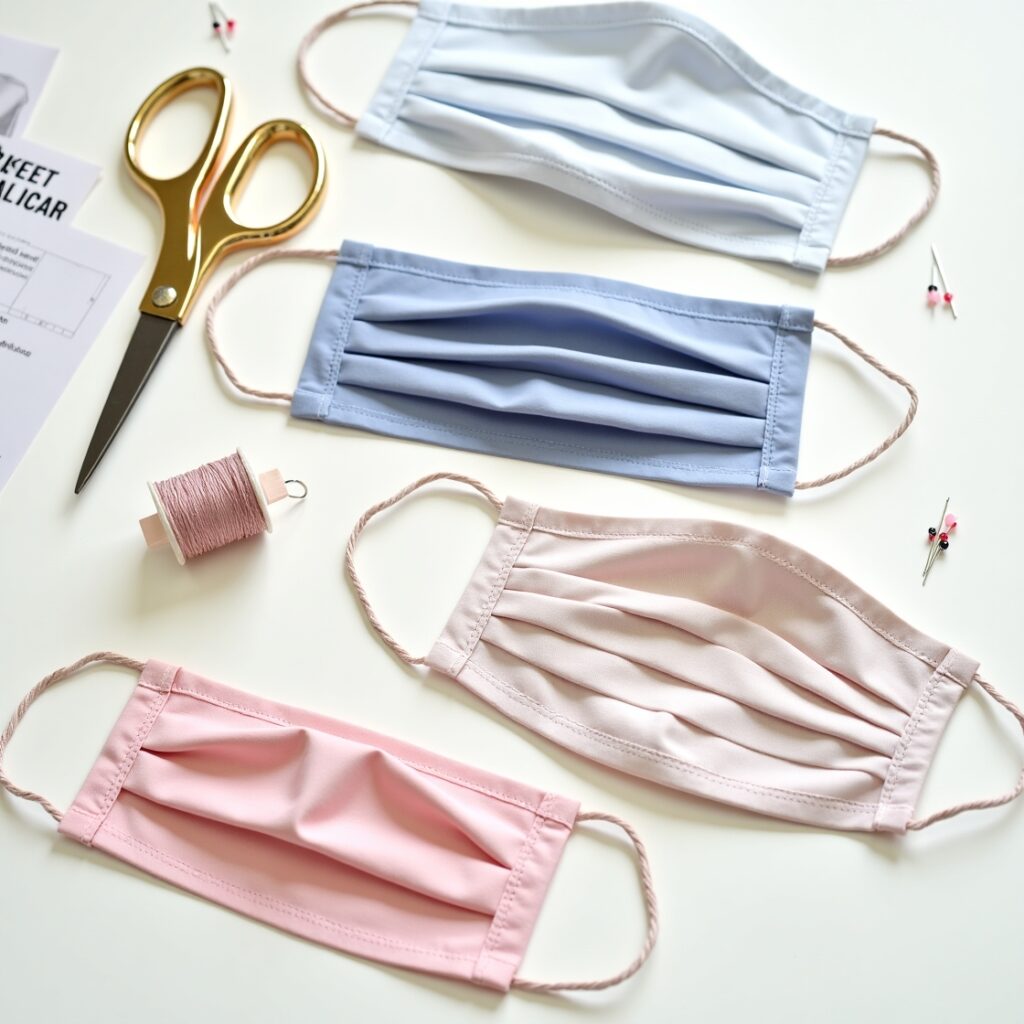Looking for a reliable face mask pattern you can sew at home? You’re in the right place. This guide gives you free printable templates (PDF) in multiple sizes, clear step-by-step sewing instructions. Whether you’re a beginner or seasoned sewist, you’ll find everything you need to create a perfectly fitting mask in under an hour.
[📥 Download the Free Printable Face Mask Pattern (Adult + Kids)]
[📥 Download 3D Free Printable Face Mask Pattern (Adult + Kids)]
What You’ll Find in This Guide
- ✅ Free printable PDF patterns (adult S, M, L, XL + kids)
- ✅ Multiple styles: pleated, fitted, 3D, and a windowed accessibility version
- ✅ Easy-to-follow sewing instructions with photos
- ✅ Tips for sizing, fitting, and customizing your mask
- ✅ Care instructions to keep your mask safe and long-lasting
Materials & Tools
Before you start, gather these essentials:
Fabrics:
- 100% cotton (quilting cotton recommended)
- Tightly woven fabrics like poplin or percale
- Optional: nonwoven filter material
Supplies:
- Elastic (¼” or ⅛” for ear loops) or fabric ties
- Nose wire (aluminum strip, floral wire, or twist tie)
- Thread, scissors, pins, sewing machine (or hand sewing tools)
Choosing the Right Mask Style

| Pattern Type | Best For | Pros | Cons |
|---|---|---|---|
| Pleated | Quick, easy sewing | Simple, flexible fit | Can gap at sides |
| Fitted/Contoured | Everyday wear | Snug, comfortable fit | Slightly more cutting |
| 3D Mask | Glasses wearers | Minimal fogging, roomy | Slightly longer to sew |
| Windowed Mask | Accessibility | Great for lip-reading & expression | Requires vinyl insert |
For official guidance on proper mask fit and usage, see the CDC’s recommendations on face coverings.
Step-by-Step Sewing Instructions
Each mask style has its own printable pattern. Below are instructions for the fitted mask, which is the most popular.
[📥 Download Fitted Mask Pattern (PDF)]
Step 1: Print & Cut the Pattern
- Print at 100% scale. Use the 1-inch (25.4 mm) test square to verify.
- Cut fabric pieces: 2 outer layers and 2 inner layers (lining).
Step 2: Sew the Center Seam
- Place right sides together and sew along the curved edge.
- Clip small notches for a smooth curve, then press open.
Step 3: Join Outer & Inner Layers
- Place right sides together, sew top and bottom edges.
- Turn the mask right side out and press flat.
Step 4: Add Elastic & Side Seams
- Insert elastic at each side, pin in place.
- Fold and sew side seams to secure.
Your fitted mask is now complete!
Scaling & Sizing
Not sure which size to use?
- Small: children 5–9 years
- Medium: teens and petite adults
- Large: average adult
- Extra Large: wider faces or bearded wearers
Pro tip: If you need to resize, adjust printer scaling (e.g., 105% to enlarge) and verify with the test square.
Troubleshooting & Fit Guide
- Mask feels loose: Shorten elastic or tie a knot.
- Glasses fogging: Use nose wire + apply a thin layer of dish soap.
- Elastic too tight: Replace with fabric ties.
- Chafing behind ears: Add soft cord stoppers or toggles.
Fun Tips to Personalize Your Face Mask Pattern
Why settle for plain masks when you can make them truly yours? Add small touches like embroidered initials, fun fabric prints, or contrasting thread colors to match your outfit. You can even use fabric paint, patches, or iron-on designs to express your personality. Not only does a custom mask make you look stylish, but it also helps kids feel excited to wear theirs. Small tweaks like adjustable ear loops or colorful elastic can make your mask more comfortable and eye-catching, turning a daily necessity into a mini fashion statement!
Face Mask Pattern FAQs
Where can I get a free printable face mask pattern?
Right here! You can download free face mask patterns in PDF and SVG formats. The set includes adult and kids sizes in pleated, fitted, 3D, and windowed styles.
What is the best fabric for sewing a face mask?
100% tightly woven cotton (such as quilting cotton or poplin) is the most recommended. It balances breathability with good filtration. Avoid stretchy knits or fabrics that are too thin.
How do I make sure my mask fits properly?
A well-fitted mask should cover your nose, chin, and sides without leaving gaps. Use a nose wire for a snug seal and choose the right size (S–XL) from our free pattern set.
Can I make a no-sew face mask at home?
Yes. If you don’t have a sewing machine, you can hand sew, or try quick no-sew options like folding a T-shirt or bandana with hair ties. However, a sewn mask provides the best durability and fit.
How do I add a filter pocket to my face mask?
Cut the lining in two pieces and leave a small opening when sewing. This creates a pocket where you can slide in safe, breathable filters. Our filter pocket mask pattern includes this feature.
Can children wear homemade face masks safely?
Yes, but only for children over 2 years old. Always supervise young kids, and use child-size patterns for comfort. Our free download includes special kids’ sizes.
Which mask style is best pleated, fitted, or 3D?
It depends on your needs. Pleated masks are quick and versatile, fitted masks give the snuggest everyday fit, and 3D masks work best for glasses wearers to reduce fogging.
Final Thoughts
Sewing your own mask is practical, creative, and rewarding. With these free printable patterns, step-by-step instructions, and video guides, you can make masks for yourself, friends, and family — quickly and safely.






